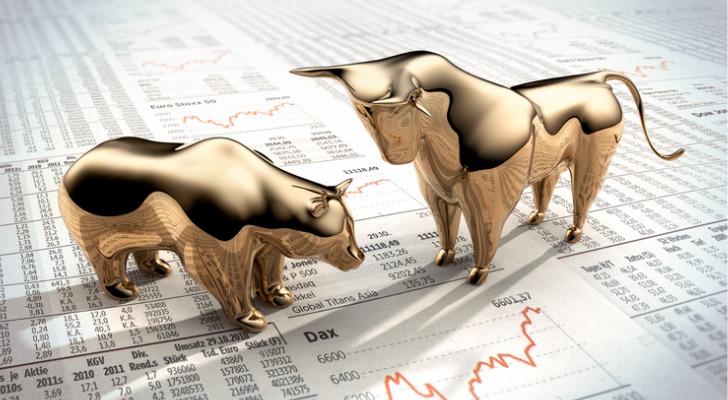The terms “bear” and “bull” in the stock market describe two distinct trends that influence investor sentiment and market movement. A bull market is when stock prices are rising, often driven by optimism and strong economic indicators. In contrast, a bear market signals declining prices and widespread caution among investors. Recognizing the differences between these market phases can help explain shifts in trading activity, investment strategies and overall economic outlook. Both bear and bull markets have shaped the history of the stock market. Their impacts continue to affect how people approach investing today.
If you need help navigating market trends, consider working with a financial advisor.
What Is a Bear Market?
A bear market refers to when stock prices fall by 20% or more from recent highs. This downturn can last for months or even years. Bear markets affect stocks but also other asset classes like bonds and real estate. Investors typically become more cautious during a bear market, and trading volumes may decrease as people wait for signs of recovery.
Why Is it Called a Bear Market?
The term “bear” is used because, much like a bear swiping its paws downward, the market is trending down. This is the opposite of a bull market, where prices are rising and optimism prevails.
Notable Bear Markets in Recent History
One of the most significant bear markets occurred in 2008, when the S&P 500 lost more than half its value in just over a year. The COVID-19 pandemic in early 2020 triggered the most recent bear market. Global markets plunged rapidly before rebounding after governments and central banks intervened during the crisis.
How Long Do Bear Markets Last?

Bear markets can be challenging, but they are not permanent. Historically, markets have always recovered over time, often emerging stronger and reaching new highs. How long do bear markets last? On average, bear markets last about 13 months. Some bear markets may be as brief as a few weeks or as long as several years. The recovery period, or the time it takes for markets to return to previous highs, also varies. Market recovery depends on the underlying causes of the downturn and the strength of the economic rebound.
Bear markets can be unsettling, especially for those new to investing. They often lead to increased volatility and can test an investor’s resolve and long-term strategy. However, bear markets are a natural part of the economic cycle. They can also present opportunities for disciplined investors to buy quality assets at lower prices.
What Is a Bull Market?
A bull market is a period in the stock market when prices are rising or are expected to rise. Typically, this term refers to a sustained increase of 20% or more in broad market indexes, such as the S&P 500, over at least two months. Investors often associate bull markets with optimism, strong economic growth, and increased investor confidence. This enthusiasm drives demand for stocks and push prices higher.
Why Is It Called a Bull Market?
The term “bull market” comes from the way a bull attacks its opponents—by thrusting its horns upward. This upward motion is symbolic of the rising trend in stock prices during these periods.
Notable Bull Markets in Recent History
One of the most remarkable bull markets in recent history began in March 2009, following the global financial crisis. This bull run lasted until early 2020, making it the longest in U.S. history at nearly 11 years. During this period, the S&P grew by more than 300% fueled by low interest rates, technological innovation, and steady economic growth.
Another notable example occurred in the 1980s and 1990s, when the market experienced a prolonged rally driven by economic expansion and the rise of the internet.
How Long Do Bull Markets Last?
Bull markets can vary significantly in length, but they generally last longer than bear markets. On average, bull markets in the United States have lasted about five years, while bear markets tend to be much shorter, often lasting less than two years. The duration of a bull market depends on factors such as economic conditions, investor sentiment and government policies.
Bear vs. Bull Market: Key Indicators to Watch

To distinguish between bear vs. bull in stock market cycles, it’s important to pay attention to several key indicators. Economic growth, unemployment rates, and consumer confidence are all critical factors that can signal the start or end of either market type.
In a bull market, you’ll typically see low unemployment, rising gross domestic product (GDP) and strong consumer spending. Conversely, a bear market often coincides with higher unemployment, shrinking GDP and reduced consumer activity.
Recognizing the signs early allows you to adjust your strategy, whether that means taking advantage of growth opportunities in a bull market or protecting your assets during a downturn. While no one can predict market movements with absolute certainty, staying informed and watching for these key signals can give you greater confidence as you navigate the stock market.
Bottom Line
Understanding the differences between bear vs bull markets is essential for anyone looking to navigate the ups and downs of investing. By recognizing the key indicators that signal shifts in market sentiment, you can make more informed decisions and adapt your strategy to changing conditions. Whether the market is trending upward or downward, staying educated about the dynamics of bullish vs. bearish in stock market cycles empowers you to manage risk and seize opportunities with greater confidence.
Tips for Portfolio Management
- How confident are you that your portfolio is positioned for today’s economy? A financial advisor can help align your portfolio for whatever happens in the market to ensure you’re on track for your long-term goals. Finding a financial advisor doesn’t have to be hard. SmartAsset’s free tool matches you with vetted financial advisors who serve your area, and you can have a free introductory call with your advisor matches to decide which one you feel is right for you. If you’re ready to find an advisor who can help you achieve your financial goals, get started now.
- It’s important to understand how your portfolio might grow over time. Consider using an investment calculator to make estimations that can help you make decisions for your own portfolio.
Photo credit: ©iStock.com/peterschreiber.media, ©iStock.com/dusanpetkovic, ©iStock.com/Paperkites
